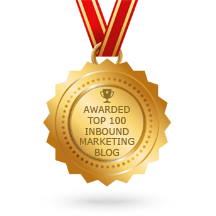 When your target market is looking - make it easy for them to find your company (not the competition), when and where and they are looking.
When your target market is looking - make it easy for them to find your company (not the competition), when and where and they are looking.
The Inbound Marketing Methodology is based on 'Getting Found' by your prospects, 'Converting' prospects into leads and customers and 'Analysing' your results to improve your lead generation and customer acquisition.
Getting found is the first step in the inbound marketing methodology. The purpose at this stage is to market your business so that qualified prospects find you (and not your competition), when they are looking. In addition to finding your company, they must find the information for which they are looking. You’ll notice it is all about the prospect, not you, not your company.
Marketing Tip: Marketers that make the switch to consumer centric marketing will be successful in building scalable, profitable businesses in the future.
Here are the 5 steps to getting found online:
1. Buyer Personas
The first step is to understand to whom you are marketing. By creating personas for the people who do, and should, buy from you will help you understand their pain points, needs, habits and values. The content you publish online should reflect what is important to them.
2. Keywords
Once you understand your buyer personas, the next step is to identify the keywords your prospects use when they are searching online. It’s important to understand these are the words your prospects use, not industry terms, jargon or acronyms. Once you have a list of keywords to start with, use a keyword tool like Google’s Keyword Tool or Hubspot's Keyword Grader. Enter in all the words and urls, into the search option to find similar words to build out your list with as many keywords as possible. Filter your keywords based on; relevancy, search volume and ability to rank (difficulty, competition). And make a list of your top 10-‐20 priority keywords.
Marketing Tip: Remember the ultimate goal here is conversion. Lower volume, highly relevant words you can rank for may yield a higher conversion rate than words based on high search volume alone, because they may be too generic or too difficult to rank for. So choose your top keywords carefully.
3. Content
Once you have completed your buyer personas and keyword research you will better understand what your prospects are looking for, and what words they use.
The next step is to publish content that will be of value to them. Content can, and should be, in the form of:
• Web pages
• Blogging
• Press releases
• eBooks
• Whitepapers
• Videos
• Images
• Presentations
• Emails
• Social media posts
4. SEO – Search Engine Optimisation
Search engine optimization (SEO) is the process of optimising your content with keywords so they show up in the search results. There are many companies that provide SEO services that use illegal practices to get quick results. Google is getting smarter at penalising these sites, so avoid them from the start. The best strategy is to build your SEO authority the right way. This will take some time but remember it also builds in momentum. The best tactic is to publish new content every day.
There are two parts to SEO optimisation; on-‐page SEO and off-‐page SEO. These are explained in more detail below.
On-page SEO: This tells the search engines, like Google, what the content is about. On-page SEO accounts for 25% towards your overall Google SEO rank. Here are some on-page SEO best practices:
- Choose one keyword phrase per page.
- Place your keyword phrase in the following areas, make sure it is unique for each page:
- URL
- Page title
- H1 – headers on the page
- Body text
- Image Alt Text
- Tags
- Internal links (within your website)
- Make sure the structure of your website is search friendly.
- Make sure there are no search errors or broken links.
- Submit your sitemap to each of the major search engines.
Off-page SEO: On-page SEO tells the search engines what your content is about, off-‐page SEO tells the search engines that you are an authority on this topic and can be trusted.This is determined by the links pointing to your content known as inbound links or backlinks. Off-‐page SEO accounts for 75% towards your Google SEO rank. Not all links are equal so the best strategy is to focus on quality, rather than quantity. The best tactic is to publish content daily, post it on your social media sites, blog and press release. Just by publishing relevant and valuable content you will attract inbound links. Don’t get tempted to fast track your results by hiring an SEO consultant that promises to get you to the front page of search results in a short time. More often than not these are black hat tactics that may get you penalised and work against you in the long term. Google recommends publishing quality content on a regular basis and writing for your target audience, not the search engines.
5. Social Media
To be successful with social media, it's important to understand the purpose it will serve for lead generation in your business. This will help with strategy, tactics and reporting. Whether you’re B2C (business to consumer) or B2B (business to business), promoting a special or directing prospects to an online store - customers first need to know you exist, and then trust you, before buying. Social media strategies should be focused on building relationships; listening, engaging and having conversations with your prospects, industry, peers and customers, this will set you up for success with; lead generation, customer conversion and referrals.
Currently there are five major social media sites, they are: Facebook, Twitter, LinkedIn, Google+ and Pinterest. It can be overwhelming at first to learn all five, so start with just one or two that are best suited to your business and do them well before starting with the others.
Getting found is only just the first part of the inbound marketing methodology – the next part is conversion. Converting traffic into leads and leads into customers – we’ll address these in the following blog articles – so make sure you subscribe to this blog to receive new articles as they are published.
Next steps:
Subscribe to the Inbound Marketing Blog
Download the ebook: Small Business Guide: Introduction to Inbound Marketing.

